The average family of 4 wastes $1,500 of food each year, according to the Natural Resources Defense Council.
It’s a fact.
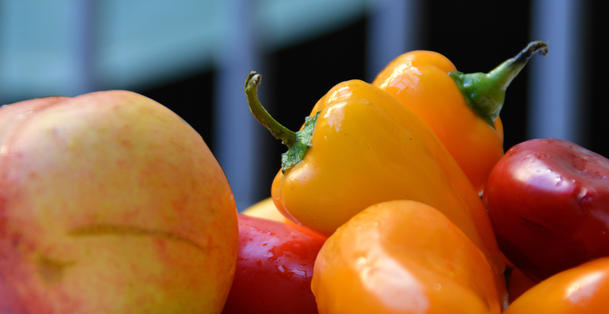
Food waste is not anything anyone sets out to do. We go to the store, buy groceries and intend to eat what we buy. But it’s not uncommon to find molding vegetables, wilted leaves or brown speckled foods hiding out in our refrigerator. It happens, but it doesn’t have to happen often. If you are ready to throw in the towel on the moldy science experiments, here is how you can do it:
Keep Healthy Foods Within Sight
“Out of sight, out of mind…” this phrase rings true for healthy foods too! If food is placed in closed containers, bins, drawers and deep places in the pantry that are not visible or easy to reach, we forget about it.
While we want to remove foods from sight that are processed, WE WANT to add foods to the counter and easy to reach places that are unprocessed and whole…fruits and veggies. If you want to remind yourself to eat the veggies and hummus when you are hungry early evening and dinner isn’t ready, make them easy to spot when you swing open the fridge door.
According to Brian Wansink, consumer behavior and nutritional science expert at Cornell University, there is 3 secrets to healthier eating using his “CAN” approach:
Convenient– make healthy foods and beverages the easy, obvious choice
Attract– display healthy foods so they look appealing
Normal-make healthy foods the default and most abundant option
Eating healthy foods consistently is about making them readily available and visible, but this same trick also helps reduce household food waste.
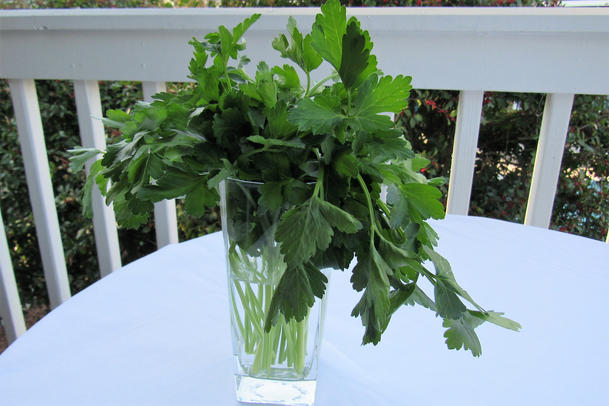
Simple Food Placement Can Help You Eat and Use Instead of Overlook and Toss:
Create a kitchen herb bouquet- Cilantro, parsley, basil- cut off the tips of the stems and place in a glass or mason jar with 1-2 inches of cool water; remove any discolored or brown leaves. Place on the counter in lit area but out of direct sunlight. Change the water every few days or when it becomes cloudy. Your herbs can stay fresh for 1-3weeks!
Use glass containers, mason jars, and see-through storage containers– these are perfect for pre-cut vegetables and fruit as well as cooked grains, roasted vegetables and any other cooked foods you made on your food prep day. If you can’t quickly see what is in the container, you will likely forget about it. I use these Rubbermaid glass storage containers and LOVE THEM!
Place the fruit bowl on the kitchen table- this is the only food that deserves to be within sight when you walk into the kitchen.
Move chopped vegetables to the top shelf of the fridge- they are ready to go for snacking, roasting, steaming or any other preparation. You can buy pre-chopped or do the prep when you get home from the grocery store.
Salvage What You Can
Bad spots and molding indicate a living food is turning, but it doesn’t mean it is not edible. Only you can make the call but if you know something is old and will need to be tossed soon, consider a few different ways to salvage these ingredients and prevent food waste:
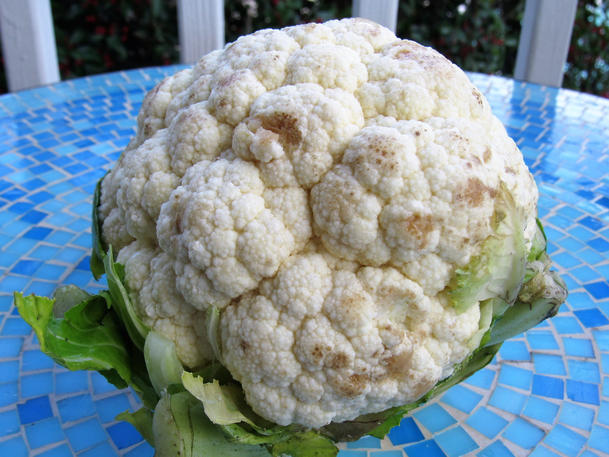
Brown speckled cauliflower– chop off bad spots, then mash or puree it!
Limp carrots, celery, root vegetables or herbs– vegetable stock
Brown Bananas– freeze for a smoothie or banana ice cream
Apples or pears that are mushy or have soft spots– toss into a crock pot to make applesauce
Overly Ripe Tomatoes– Roast with feta, balsamic and basil for a delicious side!
Basil that is starting to brown– make pesto!
Veggies or potatoes– roast!
According to the National Resources Defense Council, 48% of produce is wasted by American households! Imagine every time you go to the grocery store, unpacking your bags and tossing ½ of your fruits and vegetables directly into the trash!!
What can you salvage today?
Plan, Plan, Plan
The most common reason a food might go to waste in my kitchen is when I don’t make OR follow my meal plan.
“Failing to plan is planning to fail.” BUT, then you have to follow through with the plan. You have to commit.
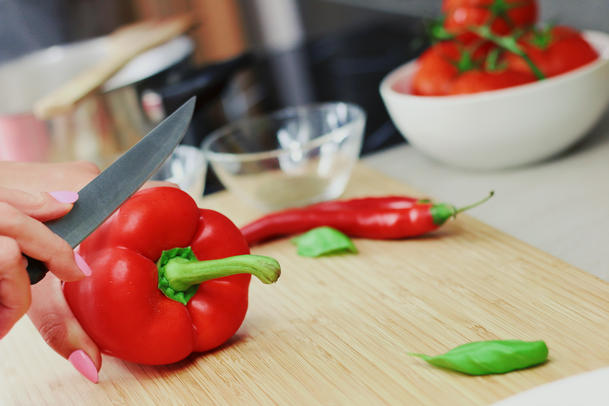
Planning doesn’t require endless hours, lists and notes, just a little intentionality, notepad and a pen.
A few tricks for planning:
-
Include 1 Pantry/Freezer meal in your meal plan each week. This is a meal that does not include any fresh meats or produce and ONLY uses foods from your pantry and freezer. There will be no waste IF you don’t get to make this meal during the week…just save it for next week. For some tips on how to create a healthy pantry/freezer meal, check out this post.
-
First, prepare the meals with ingredients that will turn the quickest. For example, prepare fresh fish on the day of or next day after purchase. Make the recipe with the fresh asparagus before you make the recipe with the frozen broccoli. Prepare the meal with the fresh pork loin before the fully cooked chicken sausages. Simply, re-order the meal sequence… no extra work required!
-
Keep your meal plan in the kitchen on the fridge or on a bulletin board so that you and all the family members are able to reference it at any time. It eliminates the question, “What’s for dinner?” and provides focus when we are frazzled. Also, write out 2-3 snacks for yourself and kids so that they know what they can reach for each day during snack time (if they don’t notice the fruit bowl you have waiting for them on the dining room table!). You can change up the snacks each week to keep it interesting and it ensures that the fresh fruit and veggies you planned for snacks are actually eaten.
Stick To Your Shopping List
When was the last time you walked into the grocery store with a list and walked out with ONLY the items on your list? Never?!? Join the club!! But, we spend more money and increase the changes of food waste every time!
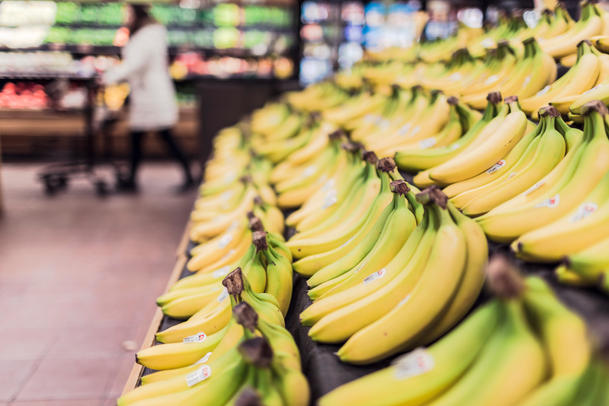
Sometimes we are making choices based on what looks fresh and appealing. Maybe the asparagus looks appealing and delicious OR maybe the mangos are perfectly ripe. Definitely, make produce choices based on what appears to be the freshest, but make sure you don’t buy more than what you intend to eat or use.
Inventory Your Pantry and Fridge 1 Time per Month
A good friend told me one time that she made dinners for her family of 4 for an entire week shopping her pantry, freezer, and fridge only– no grocery shopping required! I was astounded! I can’t claim that title, but it is true that ingredients begin to pile up and our neat and tidy shelves can easily become disheveled over several weeks with ingredients, extras, and little bits.
Plan to inventory your entire pantry, fridge, and freezer 1 time per month. Set a reminder on your calendar to do it on a specific day each month before you make a trip to the grocery store. You may find the beginning of the month is the perfect way to start fresh, but the key is choosing 1 day and sticking to it.
Then, create meals for that week that are specifically designed to help you use up those ingredients. Maybe you plan a chicken and vegetable soup with any fresh or frozen veggies you can find, canned beans, little bits of rice or grains that aren’t enough for a regular serving. Don’t forget to use up those fresh herbs you might have around. Add chopped, fresh herbs before serving so they stay flavorful and don’t lose their color.
This is the perfect time to be creative, resourceful and inventive. Who knows…maybe you will create a mouthwatering masterpiece!
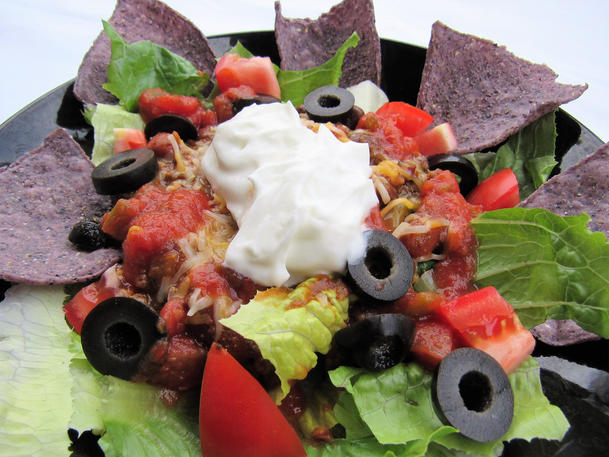
What could you do with $1500 each year?! Would you spend it? Invest it? Give it? What is 1 strategy you can implement today to save your hard earned dollars and reduce food waste?
“Wasting food is like stealing from the poor.”
–Pope Francis
References
Natural Resources Defense Council, Save the Food
DISCLOSURE: This post contains affiliate links. If you purchase a product through this link, your cost will be the same but Healthy Inspiration will receive a small commission to help with the operating costs of this blog. Thank you for your support!
